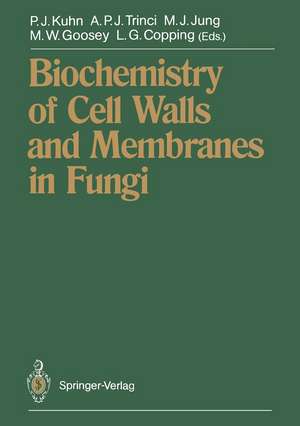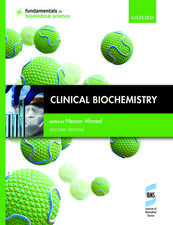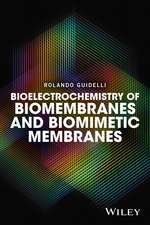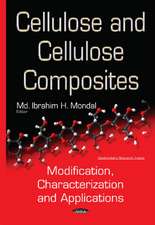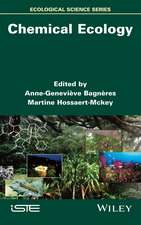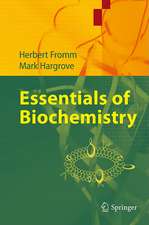Biochemistry of Cell Walls and Membranes in Fungi
Editat de Paul J. Kuhn, Anthony P. J. Trinci, Michel J. Jung, Michael W. Goosey, Leonard G. Coppingen Limba Engleză Paperback – 12 dec 2011
Preț: 949.23 lei
Preț vechi: 1157.60 lei
-18% Nou
Puncte Express: 1424
Preț estimativ în valută:
181.64€ • 190.12$ • 151.18£
181.64€ • 190.12$ • 151.18£
Carte tipărită la comandă
Livrare economică 31 martie-14 aprilie
Preluare comenzi: 021 569.72.76
Specificații
ISBN-13: 9783642742170
ISBN-10: 3642742173
Pagini: 348
Ilustrații: XIII, 327 p.
Dimensiuni: 170 x 242 x 18 mm
Greutate: 0.55 kg
Ediția:Softcover reprint of the original 1st ed. 1990
Editura: Springer Berlin, Heidelberg
Colecția Springer
Locul publicării:Berlin, Heidelberg, Germany
ISBN-10: 3642742173
Pagini: 348
Ilustrații: XIII, 327 p.
Dimensiuni: 170 x 242 x 18 mm
Greutate: 0.55 kg
Ediția:Softcover reprint of the original 1st ed. 1990
Editura: Springer Berlin, Heidelberg
Colecția Springer
Locul publicării:Berlin, Heidelberg, Germany
Public țintă
ResearchDescriere
Despite the many advances made during the last decade in various aspects of fungal biochemistry, there have been very few volumes devoted to the sub ject in recent years. This lack is all the more surprising in view of the increas ing use of fungi in gene manipulation studies and in biotechnological ap plications, and of the current interest in the biorational discovery of novel agents for the control of fungal pathogens of plants and humans. We hope that this book goes some way to rectifying this situation by providing an up to-date account of selected developments in two important areas, namely cell walls and membranes. Topics included in the book concern both yeasts and filamentous fungi. Although the main emphasis is on biogenesis, functional aspects are also discussed, e.g. the role of glycoproteins in recognition of sterols in mem branes and of calcium in regulation. Several contributions describe in terference with the 'normal' biochemistry of cell walls and membranes with a view to increasing fundamental knowledge, but also highly relevant to the design of new fungicides and antimycotics. The steadily increasing impact of molecular biology on the study of fungal biochemistry is highlighted throughout.
Cuprins
1 Cell Walls and Membranes in Fungi — An Introduction.- References.- 2 Fungal Cell Walls — A Review.- 1 Introduction.- 2 The Chemistry and Architecture of the Fungal Cell Wall.- 3 Synthesis of Cell Wall Polymers.- 4 Stability of the Cell Wall.- 5 Wall Formation During Protoplast Regeneration.- 6 Genetics and the Fungal Wall.- 7 The Cell Wall as a Target.- 8 The Cell Wall as an Interactive Surface.- 9 The Protective Role of the Cell Wall.- 10 Cell Wall Enzymes, Wall Porosity and Enzyme Secretion.- 11 Concluding Statement.- References.- 3 Chitin Synthesis in Yeast (Saccharomyces cerevisiae).- 1 Introduction.- 2 Zymogen Nature of Chitin Synthetase.- 3 Intracellular Distribution of Chitin Synthetase.- 4 Cloning of a Chitin Synthetase Structural Gene.- 5 A New Chitin Synthetase.- 6 Cloning of the Chitin Synthetase 2 Structural Gene.- 7 Requirement of Chitin Synthetase 2 for Cell Division.- 8 Chitin Synthetase 1 — A Repair Enzyme?.- 9 The Present Status of Chitin Synthesis in Yeast.- References.- 4 A Novel Computer Model for Generating Cell Shape: Application to Fungal Morphogenesis.- 1 Introduction.- 2 Current Concepts of Wall Growth in Fungi.- 3 A Model of Wall Growth Based on Vesicles.- 4 Computer Simulation of Morphogenesis.- 5 Mathematical Model for Hyphal Growth.- 6 Relationship of Spitzenkörper to VSC.- 7 The VSC Concept and Mechanisms for VSC Displacement.- 8 Simulations of Morphogenetic Processes in Fungi.- 9 Limitations.- 10 Discussion and Conclusions.- References.- 5 Inhibition of Chitin Metabolism.- 1 Chitin Metabolism as a Target for Antifungal Agents.- 2 Chitin Synthase.- 3 Glutamine-Fructose-6-P-Aminotransferase.- 4 Chitinase.- 5 Conclusions.- References.- 6 Wall Structure, Wall Growth, and Fungal Cell Morphogenesis.- 1 Introduction.- 2 Alkali-Insoluble ?-Glucan in the Mature Wall Forms Part of a Glucosaminoglycan-Glucan Complex.- 3 Secondary Structures in the Glucosaminoglycan-Glucan Wall Complex.- 4 Apical Biosynthesis and Morphogenesis of the Hyphal Wall.- 5 Mycelium-Yeast Transitions.- 6 Diffuse Extension of Hyphal Walls.- 7 Conclusions.- References.- 7 Cellulose and ?-Glucan Synthesis in Saprolegnia.- 1 Introduction.- 2 Synthesis and Deposition of Cell Wall Glucans in Saprolegnia hyphae.- 3 Cellulose Synthesis and Hyphal Morphogenesis.- 4 ?-Glucan Synthases from Saprolegnia.- 5 Purification of Glucan Synthases from Saprolegnia.- 6 Conclusions.- References.- 8 Synthesis and Function of Glycosylated Proteins in Saccharomyces cerevisiae.- 1 Introduction.- 2 Biosynthetic Pathways.- 3 Functional Aspects.- 4 Summary.- References.- 9 Lipids in the Structure and Function of Fungal Membranes.- 1 Introduction.- 2 The Membrane System.- 3 Membrane Structure.- 4 Membrane Composition.- 5 Functions of Membrane Lipids.- 6 Influence of Environment, Nutrition, and Development on Membrane Composition and Function.- 7 Conclusions.- References.- 10 Importance and Role of Sterols in Fungal Membranes.- 1 Introduction.- 2 Ergosterol: Does It Meet the Requirements of Fungal Membranes?.- 3 What Are the Consequences for the Cell to Synthesize Alkylated Sterols?.- 4 Why Ergosterol Instead of Cholesterol?.- References.- 11 HMG-CoA to Isopentenyl Pyrophosphate — Enzymology and Inhibition.- 1 Hydroxymethylglutaryl-Coenzyme A (HMG-CoA) Reductase.- 2 Isopentenyl Pyrophosphate Isomerase (IPPI).- 3 Inhibition of Mevalonate-5-Pyrophosphate Decarboxylase.- References.- 12 Isopentenyl Diphosphate to Squalene — Enzymology and Inhibition.- 1 Introduction.- 2 Isopentenyl Diphosphate: Dimethylallyl Diphosphate Isomerase.- 3 Farnesyl Diphosphate Synthetase.- 4 Squalene Synthetase.- 5 Conclusions.- References.- 13 Squalene Epoxidase — Enzymology and Inhibition.- 1 Introduction.- 2 Enzymology.- 3 Squalene Epoxidase Inhibitors.- 4 Squalene Epoxidase Inhibitors as Antifungal Agents.- References.- 14 Inhibition of Sterol Biosynthesis in Higher Plants by Analogues of High Energy Carbocationic Intermediates.- 1 Introduction.- 2 Inhibition of Phytosterol Biosynthesis by Carbocationic HEI and Transition State Analogues.- 3 Conclusions.- References.- 15 Lanosterol to Ergosterol — Enzymology, Inhibition and Genetics.- 1 Introduction.- 2 Antifungal Compounds and Their Activities.- 3 Fungal Cytochrome P-450.- 4 Conclusions and Implications for the Discovery of Novel Antifungal Agents.- References.- 16 Biosynthesis and Role of Phospholipids in Yeast Membranes.- 1 Regulation of Phospholipid Synthesis in S. cerevisiae — A Review.- 2 Regulation of Phospholipid Synthesis in S. pombe — Introduction.- 3 Roles of Phospholipids in S. cerevisiae and S. pombe.- References.- 17 Inhibitors of Phospholipid Biosynthesis.- 1 Introduction.- 2 Phospholipid Structure and Biosynthesis.- 3 Inhibitors of Phospholipid Biosynthesis.- 4 Validamycin and Edifenphos as Paramorphogens.- References.- 18 Transduction of the Calcium Signal with Special Reference to Ca2+-Induced Conidiation in Penicillium notatum.- 1 Introduction.- 2 Regulation of Intracellular Calcium.- 3 Calcium as an Intracellular Regulator.- 4 The Role of Calcium in Fungi.- 5 Ca2+, Signal Transduction and Morphogenesis in Fungi.- 6 Ca2+ and Signal Transduction in Penicillium notatum.- 7 Concluding Comments.- References.- 19 Structure and Function of Fungal Plasma-Membrane ATPases.- 1 Introduction.- 2 Membrane Appearance of the Plasma Membrane (PM) ATPase.- 3 Functional Properties of the Proton Pump.- 4 Chemistry of the Enzyme.- 5 Primary Structure and Predictions.- 6 Models for Proton Pumping.- 7 Current Directions.- References.
